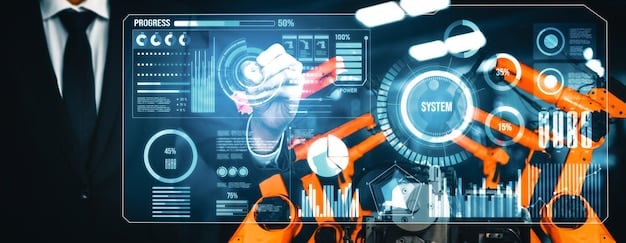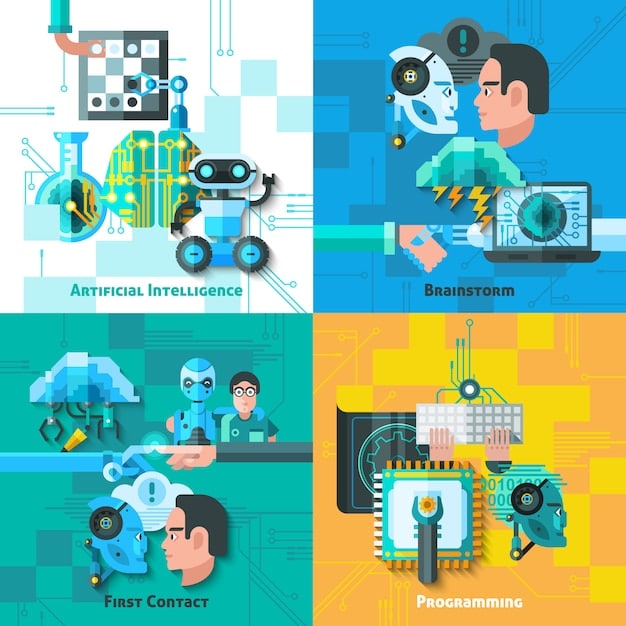AI Automation’s Impact: The Future of Work in the US (2024-2029)

AI-powered automation is poised to revolutionize the US job market over the next five years, significantly impacting various sectors through increased efficiency, new job creation, and the displacement of roles dependent on repetitive tasks.
The landscape of employment in the United States is on the cusp of a seismic shift. The rise of the future of work: how AI-powered automation will reshape the US job market in the next 5 years is not merely a technological forecast; it’s a tangible reality influencing economic sectors and workforce strategies across the nation. Understanding these transformative forces is crucial for businesses and workers.
Understanding AI-Powered Automation
AI-powered automation refers to the use of artificial intelligence to automate tasks that traditionally require human intervention. This technology is rapidly evolving, and its potential to reshape industries is immense. As AI systems become more sophisticated, they can perform tasks that once required human intelligence, such as problem-solving, decision-making, and learning.
Key Components of AI Automation
AI automation is not a monolithic entity but a combination of different components working together. Understanding these components is key to understanding its impact.
- Machine Learning (ML): Algorithms that allow systems to learn from data without explicit programming.
- Robotic Process Automation (RPA): Software robots performing repetitive tasks.
- Natural Language Processing (NLP): Enables machines to understand and process human language.
- Computer Vision: Allows machines to “see” and interpret images.

The integration of these components results in systems that can automate tasks across various sectors. This integration has led to significant advancements in productivity, efficiency, and accuracy.
The Impact of AI on Different Industries
AI’s influence spans almost all industries, from manufacturing to healthcare. While the specific impacts vary, the overarching trend is towards increased efficiency. For example, in manufacturing, AI-powered robots can perform repetitive tasks more accurately and rapidly than humans, reducing errors and increasing output. Similarly, in healthcare, AI can assist in diagnosis, treatment planning, and patient monitoring, improving patient outcomes and reducing healthcare costs.
Manufacturing
AI automation in manufacturing has led to increased productivity, reduced costs, and improved product quality. Robots and automated systems can perform tasks such as assembly, packaging, and quality control with greater precision and speed than human workers. Additionally, AI can analyze data from sensors and other sources to optimize production processes and predict equipment failures, reducing downtime and improving overall efficiency.
Healthcare
In healthcare, AI is being used to automate tasks such as appointment scheduling, patient monitoring, and diagnostic imaging. AI-powered diagnostic tools can identify diseases and conditions with greater accuracy than human doctors, leading to earlier and more effective treatment. Additionally, AI can analyze patient data to develop personalized treatment plans and predict patient outcomes, improving patient care and reducing healthcare costs.
Finance
AI is rapidly transforming the finance industry by automating tasks such as fraud detection, risk management, and customer service. AI algorithms can analyze large volumes of data to identify patterns and anomalies that indicate fraudulent activity, helping to prevent financial crimes. AI-powered chatbots and virtual assistants can provide customers with instant support and assistance, improving customer satisfaction and reducing the need for human customer service representatives.
As AI automation continues to advance, its impact on industries will only increase. Businesses need to adapt to these changes by investing in AI technology and training their employees to work alongside AI systems. Failure to do so could result in a loss of competitiveness and market share.
Job Displacement vs. Job Creation
One of the most debated topics concerning AI automation is its impact on employment. While the technology certainly has the potential to displace workers in certain roles, it also presents opportunities for new job creation. Understanding the nuances of this dynamic is critical for workforce planning and economic growth.
Potential for Job Displacement
AI automation is likely to displace workers in roles that involve repetitive, manual tasks. These include jobs in manufacturing, data entry, and customer service. As AI systems become more sophisticated, they can perform these tasks more efficiently and accurately than human workers, leading to job losses in these sectors. The scale of job displacement will depend on the speed of AI adoption and the ability of workers to adapt to changing job requirements.
Opportunities for Job Creation
Although AI automation may lead to job displacement in certain sectors, it also has the potential to create new job opportunities. These jobs will be in areas such as AI development, data science, and AI maintenance. Additionally, AI can create new business opportunities and industries, leading to the creation of entirely new job categories. Workers will need to acquire new skills and knowledge to take advantage of these opportunities.

The challenge lies in ensuring that workers have access to the education and training needed to transition to these new roles. Governments, businesses, and educational institutions must work together to provide workers with the skills and knowledge needed to succeed in the AI-driven economy. This includes investing in education and training programs, providing workers with access to online learning resources, and creating apprenticeship programs that allow workers to gain hands-on experience in AI-related fields.
Preparing the Workforce for an AI-Driven Future
Preparing the workforce for an AI-driven future involves implementing proactive changes in education, training, and workforce development policies. These changes will enable workers to develop the skills needed to thrive in a changing job market, reducing the risk of widespread job displacement.
Upskilling and Reskilling Initiatives
These initiatives are vital for workers to adapt to AI automation. Upskilling refers to enhancing existing skills, while reskilling involves learning entirely new skills. These programs can take various forms, including online courses, vocational training, and on-the-job training.
Emphasis on STEM Education
STEM education (Science, Technology, Engineering, and Mathematics) forms the foundation for many AI-related jobs. Educational institutions should prioritize STEM subjects and encourage students to pursue careers in these fields.
- Curriculum Development: Updating curriculum to include AI and machine learning concepts.
- Teacher Training: Providing teachers with the skills and knowledge to teach AI-related subjects.
- Partnerships: Collaborating with businesses to provide students with hands-on experience in AI-related fields.
By implementing these initiatives, the US can ensure that its workforce is ready for the challenges and opportunities presented by AI automation. This will involve investing in education and training programs, providing workers with access to online learning resources, and creating apprenticeship programs that allow workers to gain hands-on experience in AI-related fields.
Government Policies and Regulations
Government policies and regulations play a critical role in shaping the adoption of AI automation and mitigating its potential negative impacts. These policies and regulations can address issues such as job displacement, income inequality, and ethical concerns related to AI. By implementing effective policies, governments can ensure that AI automation benefits everyone.
Investing in Education and Training
Governments can invest in education and training programs to help workers acquire the skills and knowledge needed to succeed in the AI-driven economy. This includes providing funding for vocational training, creating apprenticeship programs, and offering incentives for workers to pursue further education.
Creating a Social Safety Net
AI automation may lead to job displacement for some workers. Governments can create a social safety net to provide these workers with financial assistance and job search support. This includes providing unemployment benefits, offering job counseling services, and funding job retraining programs.
Addressing Ethical Concerns
AI raises several ethical concerns, such as bias, discrimination, and privacy. Governments can develop regulations to address these concerns, ensuring that AI is used in a responsible and ethical manner. This includes implementing anti-discrimination laws, protecting personal data, and promoting transparency in AI decision-making.
Government policies and regulations can play a crucial role in shaping the adoption of AI automation and mitigating its potential negative impacts. By implementing these policies, governments can ensure that AI automation benefits everyone.
Future Trends in AI and Automation
The future of AI and automation is marked by several emerging trends that will further transform the job market. These include advancements in AI technology, increasing adoption across various industries, and the integration of AI with other technologies, such as the Internet of Things (IoT).
Advancements in AI Technology
AI technology is advancing rapidly. In the coming years, we can expect to see even more sophisticated AI systems that can perform tasks that currently require human intelligence. These advancements will lead to greater automation of tasks across various industries, further transforming the job market.
Increasing Adoption Across Industries
AI adoption is increasing across industries. As AI technology becomes more affordable and accessible, businesses of all sizes are starting to adopt AI systems to automate tasks and improve efficiency. This increasing adoption will lead to further job displacement in certain sectors but also create new job opportunities in others.
- Healthcare: Personalized medicine and robotic surgery.
- Transportation: Self-driving vehicles and automated logistics.
- Energy: Smart grids and predictive maintenance.
The integration of AI with other technologies, such as the Internet of Things (IoT), will create new opportunities for automation and innovation. By understanding these trends, businesses and workers can prepare for the changes that are coming and take advantage of the opportunities that AI automation presents.
| Key Point | Brief Description |
|---|---|
| 🤖 Automation | Transforming industries and increasing efficiency. |
| 💼 Job Shifts | Displacing some jobs, creating new roles in tech. |
| 📚 Upskilling | Essential for workers to adapt to new demands. |
| 🏛️ Government Role | Policies needed for ethical AI and workforce support. |
Frequently Asked Questions
▼
AI is expected to automate repetitive tasks, potentially displacing some jobs. It will also create new roles in AI development, data science, and related fields, requiring workforce adaptation.
▼
Jobs involving repetitive manual tasks, data entry, and routine customer service are most susceptible to automation. Roles requiring creativity or critical thinking are less likely to be automated.
▼
Technical skills like AI development and data analysis are crucial, along with soft skills like critical thinking, problem-solving, and creativity. Adaptability and a willingness to learn are also key.
▼
Workers can upskill and reskill by taking online courses, vocational training, or pursuing further education. Emphasis on STEM fields and continuous learning is also essential for future-proofing careers.
▼
Governments should invest in education and job training, create social safety nets for displaced workers, and regulate AI to ensure ethical use and prevent discrimination. These policies can help workers adapt.
Conclusion
As AI automation continues to advance, it is essential for businesses, workers, and governments to prepare for the changes that are coming. The future of work is being reshaped, and a proactive approach is necessary to maximize the benefits and minimize the potential risks.





